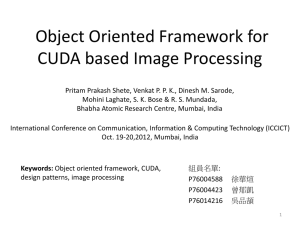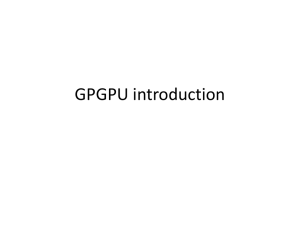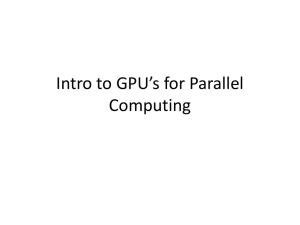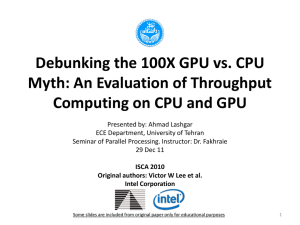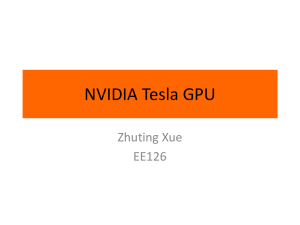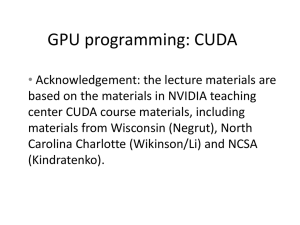Scalable Multi-Cache Simulation Using GPUs - XCG
advertisement
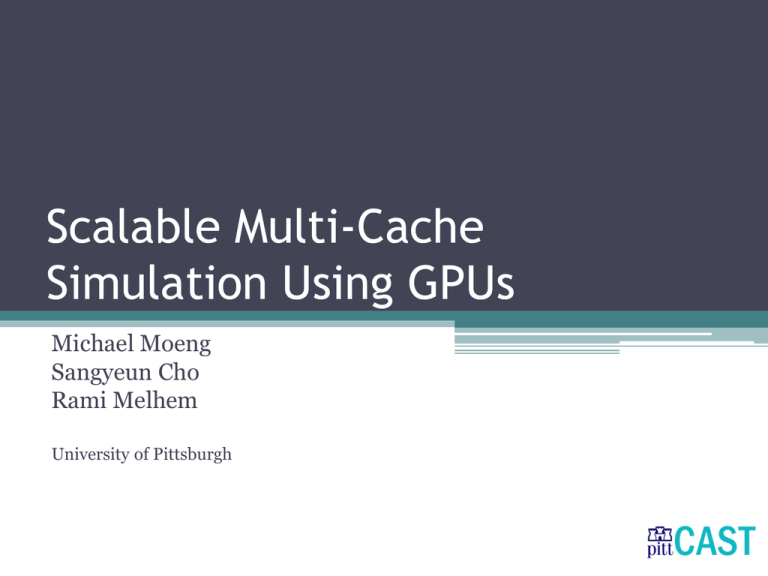
Scalable Multi-Cache Simulation Using GPUs Michael Moeng Sangyeun Cho Rami Melhem University of Pittsburgh Background • Architects simulating more cores ▫ Increasing simulation times • Cannot keep doing single-threaded simulations if we want to see results in a reasonable time frame Target Machine Host Machine Simulates Parallel Simulation Overview • A number of people have begun researching multithreaded simulation • Multithreaded simulations have some key limitations ▫ Many fewer host cores than the cores in a target machine ▫ Slow communication between threads • Graphics processors have high fine-grained parallelism ▫ Many more cores ▫ Cheap communication within ‘blocks’ (software unit) • We propose using GPUs to accelerate timing simulation • CPU acts as the functional feeder Contributions • Introduce GPUs as a tool for architectural timing simulation • Implement a proof-of-concept multi-cache simulator • Study strengths and weaknesses of GPU-based timing simulation Outline • GPU programming with CUDA • Multi-cache simulation using CUDA • Performance Results vs CPU ▫ Impact of Thread Interaction ▫ Optimizations • Conclusions CUDA Dataflow Device (GPU) Host (CPU) Main Memory Graphics Memory PCIe Bus SIMD Processors Dataflow – Concurrent CPU/GPU Device (GPU) Host (CPU) Main Memory Graphics Memory PCIe Bus SIMD Processors Dataflow – Concurrent Kernels Device (GPU) Host (CPU) Main Memory Graphics Memory PCIe Bus SIMD Processors GPU-driven Cache Simulation Trace-driven Simulation Device (GPU) Host (CPU) Statistics L1 Misses Trace Data L2 L1 kernel GPU-driven Cache Simulation • Each cache way is simulated by a thread ▫ Parallel address lookup ▫ Communicate via fast shared memory • Ways from 4 caches form a block ▫ With 16-way caches, 64 threads per block • Cache state (tags+metadata) stored in global memory – rely on caching for fast access • Experimented with tree-based reduction ▫ No performance improvement (small tree) Block-to-Block Interactions • Within a block, we can call a cheap barrier and there is no inaccuracy • Shared L2 ▫ Upon miss, L1 threads determine L2 home tile ▫ Atomically add miss to global memory buffer for L2 to process • Write Invalidations ▫ Upon write, L1 thread checks global memory for tag state of other L1 threads ▫ Atomically invalidate matching lines in global memory Evaluation • Feed traces of memory accesses to simulated cache hierarchy ▫ Mix of PARSEC benchmarks • L1/L2 cache hierarchy with private/shared L2 • GeForce GTS 450 – 192 cores (low-mid range) ▫ Fermi GPU – caching, simultaneous kernels ▫ Newer NVIDIA GPUs range from 100-500 cores Private L2 GPU sees 13-60% slowdown from 32 to 96 caches 4 Host Machine + Simulated Cache Count Simulation Time 3.5 3 CPU 32 CPU 64 CPU 96 GPU 32 GPU 64 GPU 96 2.5 2 1.5 1 0.5 0 Linear CPU A simulation scaling B C D Workload E F Multithreaded Shared L2 Largely serialized Unbalanced traffic load to a few tiles 4 Simulation Time 3.5 3 CPU 32 CPU 64 CPU 96 GPU 32 GPU 64 GPU 96 2.5 2 1.5 1 0.5 0 A B C D Workload E F Multithreaded Inaccuracy from Thread Interaction • CUDA currently has little support for synchronization between blocks • Without synchronization support, inter-thread communication is subject to error: ▫ Shared L2 caches – miss rate ▫ Write invalidations – invalidation count Controlling Error • Only way to synchronize blocks is in between kernel invocations ▫ Number of trace items processed by each kernel invocation controls error ▫ Similar techniques used in parallel CPU simulation • There is a performance and error tradeoff with varying trace chunk size 12% 10% 8% 6% 4% 2% 0% 8 32 128 512 Trace Chunk Size Error Performance CPU-only 100% 90% 80% 70% 60% 50% 40% 30% 20% 10% 0% 2048 Performance Invalidation Count Error Invalidation – Performance vs Error Shared L2 – Miss Rate Error 0.70% Miss Rate Error 0.60% Largely serialized execution minimizes error 0.50% Simulated Cache Count 0.40% 32 64 96 0.30% 0.20% 0.10% 0.00% A B C D Workload E F Concurrent Execution • Transfer memory while executing kernels • Run L1 kernel concurrently with L2 kernel Trace IO L1 Kernel Trace IO L2 Kernel L1 Kernel Trace IO L2 Kernel L1 Kernel L2 Kernel Performance Improvement Concurrent Execution Speedup Load Fromimbalance better parallel 80% among L2transfer slices utilization memory of 70% GPUcomputation and 60% Greater Benefits benefit end when when more GPU data is is transferred fully utilized 50% Cache Model 40% L1 Private Shared 30% 20% 10% 0% 32 64 Simulated Cache Tiles 96 CUDA Block Mapping • For maximum throughput, CUDA requires a balance between number of blocks and threads per block ▫ Each block can support many more threads than the number of ways in each cache • We map 4 caches to each block for maximum throughput • Also study tradeoff from fewer caches per block Block Mapping - Scaling Simulation Time 3.5 Caches per Block Fewer 3 Lower Latency 2.5 Caches per block 2 1.5 1 More Caches per Block 0.5 0 16 Saturated at 64 32 tiles 32 48 Higher Throughput 64 80 96 Simulated Cache Tiles 1 2 4 Conclusions • Even with a low-end GPU, we can simulate more and more caches with very small slowdown • With a GPU co-processor we can leverage both CPU and GPU processor time • Crucial that we balance the load between blocks Future Work • • • • Better load balance (adaptive mapping) More detailed timing model Comparisons against multi-threaded simulation Studies with higher-capacity GPUs

